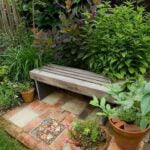In the world of garden design, decorative stones play a significant role in elevating the aesthetics and overall ambiance of outdoor spaces. From pathways to borders and focal points, the use of decorative stones offers endless possibilities for enhancing the visual appeal of gardens.
Whether you’re aiming for a modern and minimalist look or a more natural and rustic feel, incorporating decorative stones into your garden design can truly make a statement. If you’re looking for creative ways to spruce up your outdoor sanctuary, this comprehensive guide will provide you with ideas and inspiration on how to effectively utilize decorative stones in your garden landscaping.
When it comes to adding a touch of elegance and sophistication to your garden, there are various types of decorative stones that you can choose from. From gravel and crushed rock to polished pebbles and river rocks, each type has its own unique characteristics and benefits.
Understanding the different options available will help you make an informed decision on what type of decorative stone is best suited for your specific needs. With a wide range of colors, sizes, and textures to choose from, you can easily create a personalized outdoor space that reflects your individual style and preferences.
Not only do decorative stones enhance the visual appeal of gardens, but they also offer practical benefits such as water conservation, weed prevention, soil insulation, and erosion control. These versatile materials are not only aesthetically pleasing but also contribute to sustainable garden design practices.
In this article, we will explore the various ways in which decorative stones can be used to revamp your garden landscape while also promoting environmental consciousness. Whether you’re a seasoned gardener or just starting out with landscaping projects, this guide will provide you with valuable insights on how to effectively incorporate decorative stones into your outdoor oasis.
Types of Decorative Stones for Gardens
Gravel
Gravel is a popular choice for decorative stones in gardens due to its versatility and durability. It comes in various colors, sizes, and textures, allowing for a wide range of design possibilities. Pea gravel is a smaller option that provides a soft, natural look, while larger gravel can create a more dramatic effect. Gravel works well for pathways, ground cover, and as a base for garden features such as fountains or statues.
River Rock
River rocks are smooth stones that come in different sizes and colors, typically found along riverbanks or in water features. Their rounded edges and polished surface make them an attractive option for garden design. River rocks are ideal for creating dry creek beds, lining garden borders, or adding visual interest to rock gardens.
Polished Pebbles
Polished pebbles are small decorative stones that have been tumbled to achieve a smooth, shiny finish. They come in various colors and are often used to add a pop of color or texture to garden landscapes. Polished pebbles work well when placed around water features, in planters, or as part of mosaic designs.
When considering the types of decorative stones for your garden, it’s important to take into account the intended use and overall aesthetic you want to achieve. Whether you’re looking to create a tranquil oasis with calming river rocks or add bold contrast with vibrant polished pebbles, there are numerous options available to suit your unique vision.
Choosing the Right Decorative Stones for Your Garden
When it comes to choosing the right decorative stones for your garden, there are several factors to consider. The first step is to determine the purpose of the decorative stones in your garden design. Are you looking to create a focal point, add texture, or simply fill empty spaces? Once you have a clear understanding of what you want to achieve, you can then explore the various types of decorative stones available.
One important consideration when choosing decorative stones for your garden is the color. Different types of stones come in a wide range of colors, from earthy tones like browns and grays to more vibrant options like reds and blues. It’s essential to select colors that complement the overall aesthetic of your garden and blend well with existing landscaping elements.
In addition to color, you should also think about the size and shape of the decorative stones. Some gardens may benefit from smaller, uniform-sized pebbles for a smooth, consistent look, while others may call for larger, irregularly shaped rocks for a more natural appearance. The texture of the stones is another aspect to consider – whether you prefer smooth polished pebbles or rougher, more rustic-looking rocks.
| Decorative Stone Type | Description |
|---|---|
| River Rock | Natural and smooth stones that come in various sizes and colors. |
| Lava Rock | Porous volcanic rocks that are lightweight and add unique texture. |
| Pea Gravel | Small, rounded stones that are great for pathways and drainage. |
Creative Ways to Use Decorative Stones in Garden Landscaping
Decorative stones can be a versatile and stylish addition to any garden landscaping project. They not only add visual interest, but they also serve functional purposes such as weed control, moisture retention, and erosion prevention. Here are some creative ways to use decorative stones in garden landscaping.
Rock Gardens
One popular way to incorporate decorative stones into garden landscaping is by creating a rock garden. This involves strategically placing different types of decorative stones to mimic a natural rocky landscape. Rock gardens can be designed in various sizes and shapes, and they can feature unique arrangements of rocks and boulders to create a visually stunning focal point in the garden.
Edging and Borders
Decorative stones can also be used as edging or borders for flower beds, walkways, or patios. By using decorative stones along the borders of these areas, you can create a defined and polished look for your garden. This not only adds a decorative touch but also helps keep soil and mulch in place while preventing weeds from encroaching into the designated areas.
Water Features
Incorporating decorative stones into water features such as ponds, fountains, or streams can enhance the overall aesthetics of the garden. The combination of water and stone creates a tranquil and soothing atmosphere that adds a sense of zen to any outdoor space. Additionally, the contrast between the smooth surface of the stones and the reflective quality of water creates an eye-catching element within the garden landscape.
By using decorative stones creatively in your garden landscaping, you can elevate the overall design while adding texture, color, and functionality to your outdoor space. Whether it’s through rock gardens, edging and borders, or water features, there are endless possibilities for incorporating decorative stones into your garden design.
DIY Projects
When it comes to creating a unique and visually appealing garden, using decorative stones for pathways can be an excellent DIY project. Not only do garden pathways add functionality by providing a designated walkway, but they also enhance the overall aesthetic of your outdoor space. There are numerous creative ways to incorporate decorative stones into your garden pathways, allowing you to personalize and customize your landscape design.
One popular option for using decorative stones in garden pathways is to create a mosaic pattern. By carefully arranging different colored and shaped stones, you can design a beautiful and intricate pathway that becomes a focal point of your garden. Another idea is to use larger flat stones as stepping stones, surrounded by smaller decorative pebbles or gravel. This creates a natural and organic look while still providing a stable walking surface.
If you’re feeling particularly ambitious, you can even construct a dry-laid stone pathway using various types of decorative stones. This involves carefully fitting together individual stones without the use of mortar or concrete, resulting in a charming rustic look that complements natural surroundings. No matter what style or design you choose for your garden pathways, incorporating decorative stones will undoubtedly elevate the visual appeal of your outdoor space.
In addition to their aesthetic value, using decorative stones for garden pathways also offers practical benefits. They help prevent erosion and soil compaction in high-traffic areas while also minimizing maintenance requirements. With proper installation and edging, decorative stone pathways can effectively control weed growth and allow for efficient water drainage throughout your garden landscape.
| DIY Project Ideas | Description |
|---|---|
| Mosaic Pathway | Create an intricate pattern using different colored and shaped stones |
| Stepping Stone Design | Use larger flat stones surrounded by pebbles or gravel for a natural look |
The Benefits of Using Decorative Stones in Sustainable Garden Design
Decorative stones are an excellent option for creating sustainable garden designs. Not only do they add a natural and rustic look to your garden, but they also offer numerous benefits for the environment. Here are some reasons why incorporating decorative stones into your garden design can contribute to sustainability:
- Water Conservation: Using decorative stones in your garden reduces the need for excessive watering. These stones help retain moisture in the soil, which is essential for plant growth, especially during hot and dry periods.
- Low Maintenance: Decorative stones require minimal maintenance compared to traditional grass or mulch. This means less need for water, fertilizers, and pesticides, leading to a more eco-friendly gardening approach.
- Reduction of Soil Erosion: Decorative stones act as a natural barrier that helps reduce soil erosion caused by heavy rainfall or strong winds. By preventing erosion, these stones contribute to preserving the quality of the soil in your garden.
In addition to these environmental benefits, using decorative stones in sustainable garden design also has aesthetic advantages. The wide variety of colors, shapes, and sizes available allows you to create visually appealing landscapes while promoting eco-friendly practices.
By choosing materials such as river rocks, pea gravel, or crushed granite for your garden pathways or landscaping features, you can significantly reduce the environmental impact of your outdoor space while enhancing its overall beauty and functionality. With proper planning and creativity, incorporating decorative stones into your garden can result in an aesthetically pleasing and environmentally friendly outdoor space.
Maintaining Decorative Stones in Gardens
When it comes to maintaining decorative stones in your garden, there are a few simple tips and tricks that can help keep them looking great year-round. Here are some expert suggestions for keeping your garden’s decorative stones in top condition:
1. Regular Cleaning: One of the most important aspects of maintaining decorative stones in gardens is regular cleaning. Use a garden hose or pressure washer to remove dirt, debris, and built-up grime from the surface of the stones. For deeper cleaning, a gentle scrub with a mixture of water and mild detergent can help get rid of stubborn stains.
2. Weed Control: To prevent unsightly weeds from growing between your decorative stones, it’s essential to keep up with weed control. Consider using a commercial weed barrier or applying natural herbicides to prevent weed growth without harming your plants or the environment.
3. Replenishment: Over time, decorative stones may become displaced or worn down due to foot traffic or exposure to the elements. Periodically check for any areas that need replenishment and add new stones as needed to maintain an even and cohesive look throughout your garden.
By following these tips for maintaining decorative stones in gardens, you can ensure that your outdoor space continues to look beautiful and well-kept for years to come. Whether you have a small rock garden or an expansive landscape with various stone features, these simple maintenance practices will help preserve the beauty of decorative stones in your garden.
Enhancing the Aesthetics of Your Garden With Decorative Stones
Incorporating decorative stones into your garden design can significantly elevate the overall aesthetics of your outdoor space. One creative idea is to use large decorative stones as focal points within your garden. Placing a few large decorative stones strategically throughout your garden can add visual interest and create a sense of balance and harmony. These large stones can also serve as natural sculptures, adding a touch of artistry to your outdoor space.
Another inspiring way to use decorative stones in garden design is by creating unique patterns or designs on the ground using different colored or textured stones. For example, you can create a geometric pattern using contrasting colors of decorative pebbles or lay out a pathway using irregularly-shaped stepping stones. These creative stone arrangements can add depth and personality to your garden, making it a truly unique and personalized outdoor retreat.
Furthermore, consider utilizing decorative stones as part of water features in your garden. From natural stone fountains to pebble-embellished ponds, incorporating decorative stones into water elements adds a tranquil and serene ambiance to your garden while enhancing its beauty. The combination of water and stone creates a soothing environment that invites relaxation and contemplation. Additionally, adding small sparkling decorative stones within the water feature can bring life and movement to the overall design.
Overall, there are countless ways to enhance the aesthetics of your garden with decorative stones. Whether you opt for bold statement pieces, intricate ground patterns, or incorporating them into water features, these inspirational ideas demonstrate the versatility and beauty of using decorative stones in garden design. With some creativity and imagination, you can transform your outdoor space into a stunning oasis that reflects your personal style and enhances the natural beauty of your landscape.
Conclusion
In conclusion, the use of decorative stones in garden design can truly elevate the aesthetic appeal of any outdoor space. Whether you opt for natural river rocks, smooth pebbles, or colorful gravel, the right choice of decorative stones can complement your plantings and hardscape elements, adding texture, color, and visual interest to your garden.
When choosing the right decorative stones for your garden, it’s important to consider not only the aesthetic appeal but also their practicality and compatibility with your existing landscape design. By carefully selecting the appropriate type and size of decorative stones, you can enhance the overall look of your garden while also improving its functionality and sustainability.
From creating meandering pathways to accentuating focal points and defining garden borders, there are countless creative ways to use decorative stones in garden landscaping. These versatile materials offer endless possibilities for DIY projects that can add character and charm to any outdoor space.
By incorporating unique patterns, arrangements, and even artistic installations using decorative stones, you can personalize your garden design and make a statement with your landscaping choices. Whether you have a small urban oasis or a spacious rural retreat, exploring different ideas and examples for enhancing your garden with decorative stones can inspire you to transform your outdoor space into a more inviting and visually stunning environment.
Frequently Asked Questions
What Type of Stone It Is Best for Garden?
The best type of stone for a garden is one that is durable and can withstand outdoor elements. Popular choices include limestone, granite, and river rocks. These stones can add visual interest and texture to the garden while also serving practical purposes.
How Do You Decorate a Garden With Stones?
Stones can be used to decorate a garden in various ways. They can be arranged to create pathways, decorative borders, or even as focal points in the garden. Additionally, stones can be used in combination with plants to create rock gardens or as part of water features such as ponds or fountains.
What Is the Cheapest Rock for Landscaping?
The cheapest rock for landscaping is typically crushed gravel or pea gravel. These materials are affordable and versatile, making them popular choices for covering large areas in the garden. While they may not have the visual appeal of more expensive stones, they can still be used creatively in landscaping projects.

Welcome to my gardening blog! I am passionate about plants and enjoy sharing my knowledge and experiences with others. In this blog, I will write about everything related to gardening, from tips on how to get started to updates on my own garden projects.





